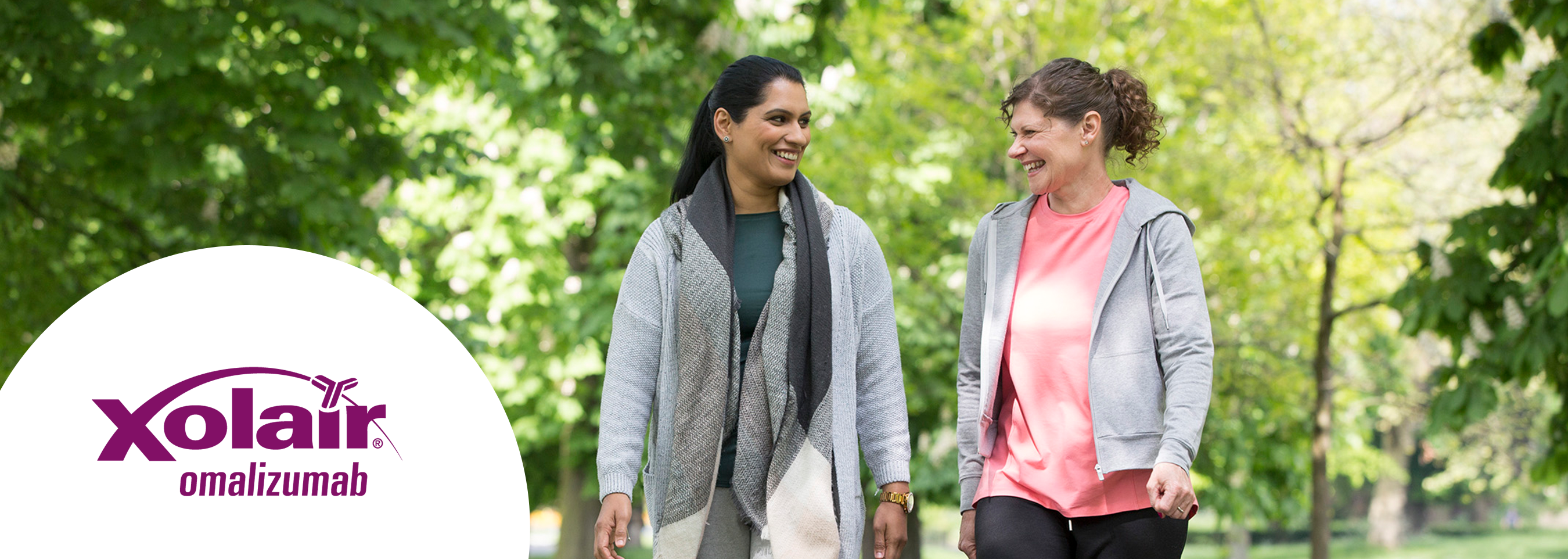Xolair® (omalizumab) resources
Downloadable materials to support the use of Xolair in day-to-day practice.
This page is intended for UK healthcare professionals and other relevant decision makers only. If you are a member of the public, please click here.
This portal is funded and owned by Novartis Pharmaceuticals UK Ltd and includes content approved by Novartis.
Adverse events reporting information can be found in the footer of this page.
Please refer to the Xolair Summary of Product Characteristics (SmPC) for full information on safety, warnings and precautions, special populations, drug interactions and other important considerations.1
Indications in severe allergic asthma (SAA):1
Xolair is indicated in adults, adolescents and children (6 to <12 years of age).
Xolair treatment should only be considered for patients with convincing immunoglobulin E (IgE) mediated asthma.
Adults and adolescents (12 years of age and older)
Xolair is indicated as add-on therapy to improve asthma control in patients with severe persistent allergic asthma who have a positive skin test or in vitro reactivity to a perennial aeroallergen and who have reduced lung function (FEV1 <80%) as well as frequent daytime symptoms or night-time awakenings and who have had multiple documented severe asthma exacerbations despite daily high-dose inhaled corticosteroids, plus a long-acting inhaled beta2-agonist.
Children (6 to <12 years of age)
Xolair is indicated as add-on therapy to improve asthma control in patients with severe persistent allergic asthma who have a positive skin test or in vitro reactivity to a perennial aeroallergen and frequent daytime symptoms or night-time awakenings and who have had multiple documented severe asthma exacerbations despite daily high-dose inhaled corticosteroids, plus a long-acting inhaled beta2-agonist.
Please refer to the Xolair Summary of Product Characteristics (SmPC) for the full therapeutic indications.1
The safety profile of Xolair in people with SAA has been established in both RCTs and real-world studies.1–4
Xolair has a moderate amount of data in pregnant women, and use may be considered during pregnancy if clinically needed.1
Xolair has a shelf life of 18 months at 2–8 °C; it can be kept for 48 hours at 25 °C. Do not freeze.1
For full information on safety, warnings and precautions, special populations, drug interactions and other important considerations, please refer to the Xolair SmPC.1
During allergic asthma clinical trials, the most commonly reported adverse reactions were:
Most of the reactions were mild or moderate in severity.
In clinical trials in patients ≥18 years of age in CRSwNP, the most commonly reported adverse reactions were headache, dizziness, arthralgia, abdominal pain upper and injection site reactions.
Adverse reactions recorded in clinical studies in the total allergic asthma and chronic rhinosinusitis with nasal polyps (CRSwNP) safety population treated with Xolair are included in the table below.
Within each frequency grouping, adverse reactions are presented in order of decreasing seriousness. Frequency categories are defined as: very common (≥1/10), common (≥1/100 to <1/10), uncommon (≥1/1,000 to <1/100), rare (≥1/10,000 to <1/1,000) and very rare (<1/10,000). Reactions reported in the post-marketing setting are listed with frequency not known (cannot be estimated from the available data).
Infections and infestations | |
Uncommon | Pharyngitis |
Rare | Parasitic infection |
Blood and lymphatic system disorders | |
Not known | Idiopathic thrombocytopenia, including severe cases |
Immune system disorders | |
Rare | Anaphylactic reaction, other serious allergic conditions, anti-omalizumab antibody development |
Not known | Serum sickness, may include fever lymphadenopathy |
Nervous system disorders | |
Common | Headache* |
Uncommon | Syncope, paraesthesia, somnolence, dizziness† |
Vascular disorders | |
Uncommon | Postural hypotension, flushing |
Respiratory, thoracic and mediastinal disorders | |
Uncommon | Allergic bronchospasm, coughing |
Rare | Laryngoedema |
Not known | Allergic granulomatous vasculitis (i.e. Churg–Strauss syndrome) |
Gastrointestinal disorders | |
Common | Abdominal pain upper†‡ |
Uncommon | Dyspeptic signs and symptoms, diarrhoea, nausea |
Skin and subcutaneous tissue disorders | |
Uncommon | Photosensitivity, urticaria, rash, pruritus |
Rare | Angioedema |
Not known | Alopecia |
Musculoskeletal and connective tissue disorders | |
Common | Arthralgia§ |
Rare | Systemic lupus erythematosus (SLE) |
Not known | Myalgia, joint swelling |
General disorders and administration site conditions | |
Very common | Pyrexia‡ |
Common | Injection site reactions such as swelling, erythema, pain, pruritus |
Uncommon | Influenza-like illness, swelling arms, weight increase, fatigue |
Adapted from Xolair® (omalizumab) Summary of Product Characteristics.1
*Very common in children 6 to <12 years of age.
†Common in nasal polyp trials.
‡In children 6 to <12 years of age.
§Unknown in allergic asthma trials.
For full information on safety, warnings and precautions, special populations, drug interactions and other important considerations, please refer to the Xolair SmPC.1
For full information on safety, warnings and precautions, special populations, drug interactions and other important considerations, please refer to the Xolair SmPC.1
Hypersensitivity to the active substance or to any of the excipients:
L-arginine hydrochloride
L-histidine hydrochloride
L-histidine
Polysorbate 20
Water for injections
Traceability
In order to improve the traceability of biological medicinal products, the name and the batch number of the administered product should be clearly recorded.
General
Xolair is not indicated for the treatment of acute asthma exacerbations, acute bronchospasm or status asthmaticus.
Xolair has not been studied in patients with hyperimmunoglobulin E syndrome or allergic bronchopulmonary aspergillosis or for the prevention of anaphylactic reactions, including those provoked by food allergy, atopic dermatitis, or allergic rhinitis. Xolair is not indicated for the treatment of these conditions.
Xolair therapy has not been studied in patients with autoimmune diseases, immune complex-mediated conditions, or pre-existing renal or hepatic impairment . Caution should be exercised when administering Xolair in these patient populations.
Abrupt discontinuation of systemic or inhaled corticosteroids after initiation of Xolair therapy in allergic asthma or CRSwNP is not recommended. Decreases in corticosteroids should be performed under the direct supervision of a physician and may need to be performed gradually.
Immune system disorders
Allergic reactions type I
Type I local or systemic allergic reactions, including anaphylaxis and anaphylactic shock, may occur when taking Xolair, even after a long duration of treatment. However, most of these reactions occurred within 2 hours after the first and subsequent injections of Xolair but some started beyond 2 hours and even beyond 24 hours after the injection. The majority of anaphylactic reactions occurred within the first 3 doses of Xolair. Therefore, the first 3 doses must be administered either by or under the supervision of a healthcare professional. A history of anaphylaxis unrelated to Xolair may be a risk factor for anaphylaxis following Xolair administration. Therefore for patients with a known history of anaphylaxis, Xolair must be administered by a health care professional, who should always have medicinal products for the treatment of anaphylactic reactions available for immediate use following administration of Xolair. If an anaphylactic or other serious allergic reaction occurs, administration of Xolair must be discontinued immediately, and appropriate therapy initiated. Patients should be informed that such reactions are possible, and prompt medical attention should be sought if allergic reactions occur.
Antibodies to Xolair have been detected in a low number of patients in clinical trials. The clinical relevance of anti-Xolair antibodies is not well understood.
Serum sickness
Serum sickness and serum sickness-like reactions, which are delayed allergic type III reactions, have been seen in patients treated with humanised monoclonal antibodies including Xolair. The suggested pathophysiologic mechanism includes immune-complex formation and deposition due to development of antibodies against Xolair. The onset has typically been 1-5 days after administration of the first or subsequent injections, also after long duration of treatment. Symptoms suggestive of serum sickness include arthritis/arthralgias, rash (urticaria or other forms), fever and lymphadenopathy. Antihistamines and corticosteroids may be useful for preventing or treating this disorder, and patients should be advised to report any suspected symptoms.
Churg-Strauss syndrome and hypereosinophilic syndrome
Patients with severe asthma may rarely present systemic hypereosinophilic syndrome or allergic eosinophilic granulomatous vasculitis (Churg-Strauss syndrome), both of which are usually treated with systemic corticosteroids.
In rare cases, patients on therapy with anti-asthma medicinal products, including Xolair, may present or develop systemic eosinophilia and vasculitis. These events are commonly associated with the reduction of oral corticosteroid therapy.
In these patients, physicians should be alert to the development of marked eosinophilia, vasculitic rash, worsening pulmonary symptoms, paranasal sinus abnormalities, cardiac complications, and/or neuropathy.
Discontinuation of Xolair should be considered in all severe cases with the above mentioned immune system disorders.
Parasitic (helminth) infections
IgE may be involved in the immunological response to some helminth infections. In patients at chronic high risk of helminth infection, a placebo-controlled trial in allergic patients showed a slight increase in infection rate with Xolair, although the course, severity, and response to treatment of infection were unaltered. The helminth infection rate in the overall clinical programme, which was not designed to detect such infections, was less than 1 in 1,000 patients. However, caution may be warranted in patients at high risk of helminth infection, in particular when travelling to areas where helminthic infections are endemic. If patients do not respond to recommended anti-helminth treatment, discontinuation of Xolair should be considered.
Latex-sensitive individuals
The removable needle cap of this pre-filled syringe contains a derivative of natural rubber latex. No natural rubber latex has to date been detected in the removable needle cap. Nevertheless, the use of Xolair solution for injection in pre-filled syringe in latex-sensitive individuals has not been studied and thus there is a potential risk for hypersensitivity reactions which cannot be completely ruled out.
CRSwNP, chronic rhinosinusitis with nasal polyps; FEV1, forced expiratory volume in 1 second; IgE, immunoglobulin E; IgG, immunoglobulin G; RCT, randomised controlled trial; SAA, severe allergic asthma; SLE, systemic lupus erythematosus; SmPC, summary of product characteristics.
References
Xolair® (omalizumab) Summary of Product Characteristics.
Humbert M, et al. Allergy 2005;60(3):309–316.
Papaioannou AI, et al. Allergy Asthma Proc 2021;42(3):235–242.
Menzella F, et al. J Asthma Allergy 2022;15:505–515.
UK | May 2025 | FA-11360006-1
Adverse events should be reported. Reporting forms and information can be found at www.mhra.gov.uk/yellowcard. Adverse events should also be reported to Novartis online through the pharmacovigilance intake (PVI) tool at www.novartis.com/report, or alternatively email [email protected] or call 01276 698370.

